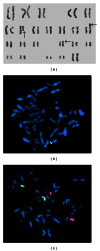Clonal Hypereosinophilia with ETV6 Rearrangement Evolving to T-Cell Lymphoblastic Lymphoma: A Case Report and Review of the Literature
- PMID: 23710385
- PMCID: PMC3654631
- DOI: 10.1155/2013/652745
Clonal Hypereosinophilia with ETV6 Rearrangement Evolving to T-Cell Lymphoblastic Lymphoma: A Case Report and Review of the Literature
Abstract
Hypereosinophilia, either clonal or reactive, has been described in association with multiple hematological malignancies. We describe a case of a patient presenting with hypereosinophilia that evolved into T-cell lymphoblastic lymphoma. Complete remission was achieved with chemotherapy; however, hypereosinophilia recurred 5 months later in association with myeloblastic bone marrow infiltration and without evidence of lymphoblastic lymphoma relapse. Cytogenetic analysis of the bone marrow showed a complex translocation involving chromosomes 7, 12, and 16. A rearrangement of ETV6 gene (12p13) was demonstrated by FISH studies, thus confirming the clonality of this population. The association of lymphoblastic lymphoma, eosinophilia, and myeloid hyperplasia has been described in disorders with FGFR1 rearrangements. We hypothesize that other clonal eosinophilic disorders lacking this rearrangement could behave in a similar fashion through different pathogenic mechanisms.
Figures


References
-
- Swerdlow SH, Campo E, Harris NL, et al. WHO Classification of Tumours of Haematopoietic and Lymphoid Tissues. 4th edition. Lyon, France: IARC Press; 2008.
-
- Spitzer G, Garson OM. Lymphoblastic leukemia with marked eosinophilia: a report of two cases. Blood. 1973;42(3):377–384. - PubMed
-
- Ayyub M, Anwar M, Luqman M, Ali W, Bashir M, Bain BJ. A case of hypereosinophilic syndrome developing Hodgkin’s disease after 4 years. British Journal of Haematology. 2003;123(5):955–956. - PubMed
-
- Larson RA, Dodge RK, Linker CA, et al. A randomized controlled trial of filgrastim during remission induction and consolidation chemotherapy for adults with acute lymphoblastic leukemia: CALGB study 9111. Blood. 1998;92(5):1556–1564. - PubMed
-
- Roufosse F, Garaud S, De Leval L. Lymphoproliferative disorders associated with hypereosinophilia. Seminars in Hematology. 2012;49(2):138–148. - PubMed
LinkOut - more resources
Full Text Sources
Other Literature Sources
Miscellaneous

